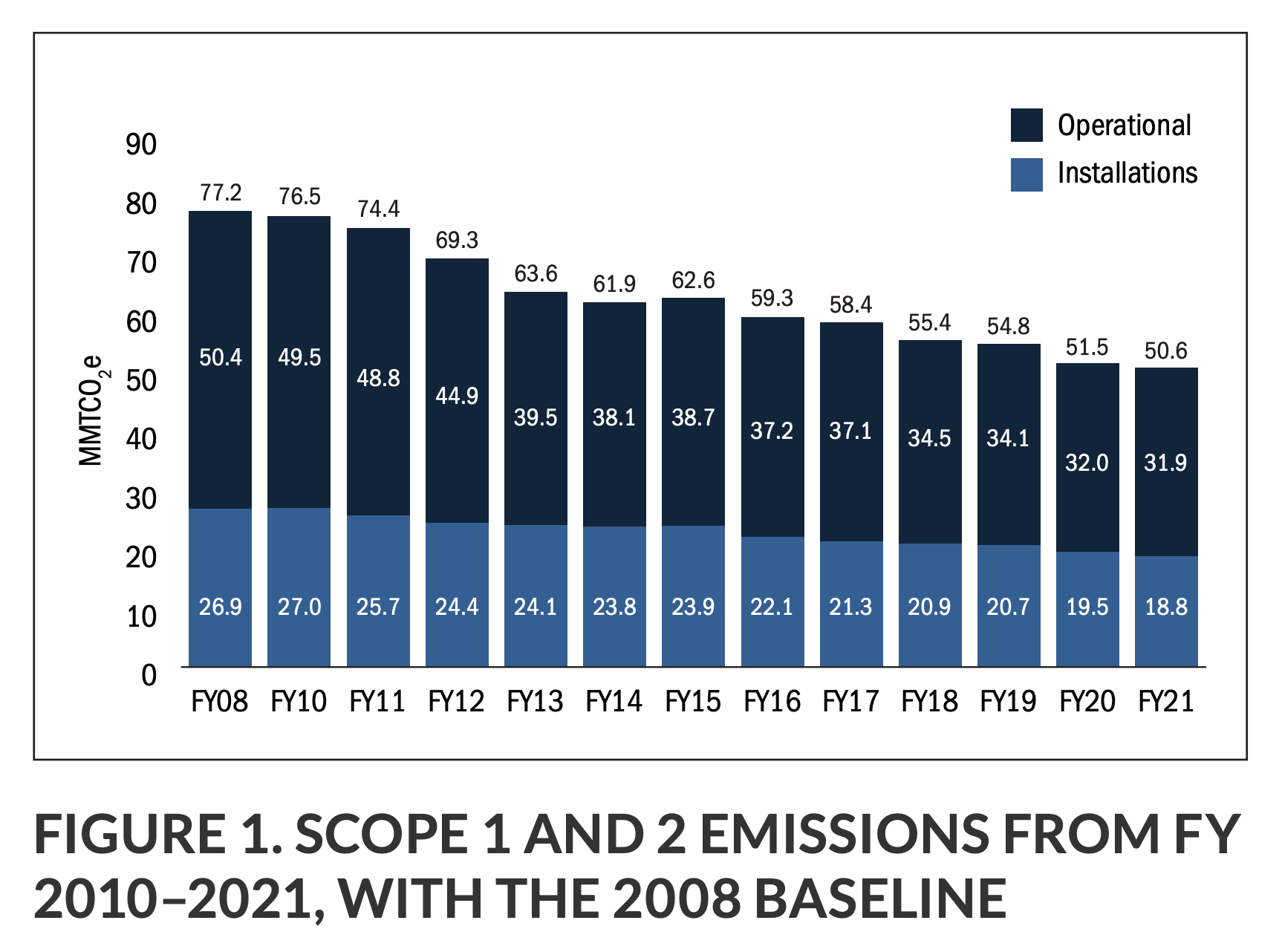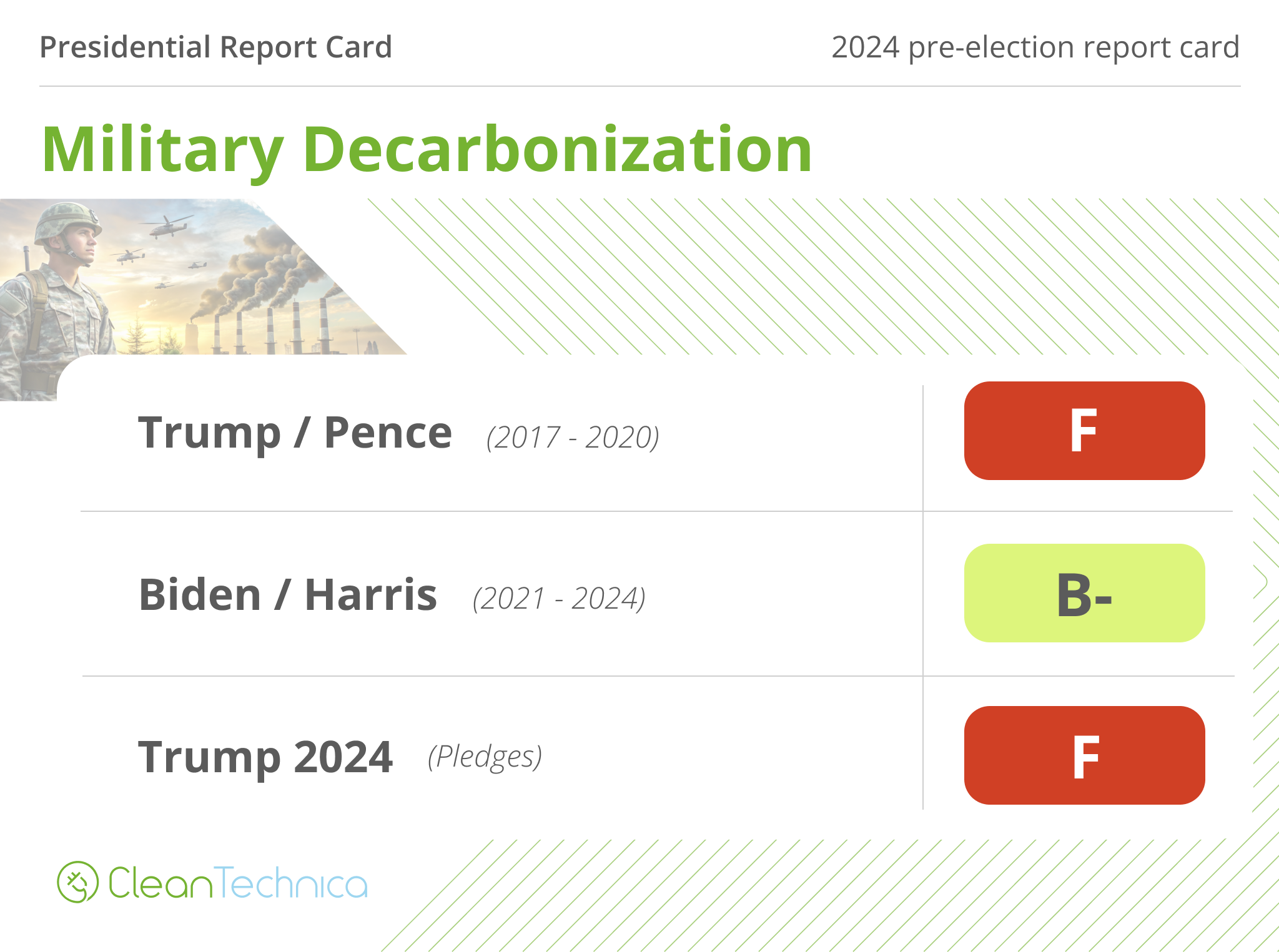Sign up for daily news updates from CleanTechnica on email. Or follow us on Google News!

As noted four years ago in the previous report card, the US military consumes 80% of all of the energy that the federal government uses annually. It’s likely the single biggest consumer of fossil fuels on the planet. One of Obama’s biggest climate wins was bringing 230,000 troops back from overseas deployments as he ended the severely misguided invasion of Iraq and significantly reduced USA’s presence in Afghanistan in preparation for full withdrawal. All else has paled by comparison.
Obama also brought the USA into the Paris Agreement, which had the notable feature of making military emissions recording and publication voluntary, unlike Kyoto, which explicitly excluded them. The voluntary nature of the reporting didn’t stop US Republicans from opposing the entire Paris Agreement on the grounds of military emissions. Trump took the USA out of the Agreement immediately upon taking office, so no debate on voluntary reporting to align with those provisions even entered agendas. Biden brought the USA back into the Agreement, and so the provisions regarding optional military emissions reporting came back into play.

In April of 2023, the Department of Defense (DoD) did report on emissions. In FY 2021, the Department of Defense (DoD) reported a total of 51 million metric tons of carbon dioxide equivalent (MMTCO2e) emissions from Scope 1 and Scope 2 sources. Of this, 63% (32 MMTCO2e) came from operational sources, primarily due to jet fuel combustion, which alone accounted for 50% of the total emissions. The remaining 37% (19 MMTCO2e) originated from installations, with purchased electricity contributing 60% of these emissions, followed by fuel combustion in buildings (28%) and in non-tactical vehicles and equipment (7%). The DoD’s emissions represented 76% of total federal government emissions and 1% of the United States’ total emissions in 2020, highlighting the significant environmental impact of military operations and infrastructure.
For context, the 501 million tons of CO2e makes the US military a higher emitter by itself than a full three quarters of the countries in the world.
The Biden–Harris administration has embarked on an ambitious campaign to drastically cut the U.S. military’s carbon emissions as part of its broader climate strategy. Central to this plan is the transition to net-zero emissions by 2050, with an interim target of reducing greenhouse gas emissions by 65% by 2030. The Department of Defense (DoD) is set to shift to 100% zero-emission vehicle acquisitions by 2035, starting with light-duty vehicles by 2027, and will use carbon pollution-free electricity by 2035. Additionally, all military buildings are expected to achieve net-zero emissions by 2045, involving significant upgrades to energy efficiency and waste reduction measures.
The administration is also leveraging federal procurement to drive sustainability, requiring major contractors to disclose their greenhouse gas emissions and set science-based reduction targets. This “buy clean” initiative promotes the use of low-carbon materials and ensures sustainable product procurement across federal operations. These efforts are part of a comprehensive strategy to incorporate climate considerations into all facets of federal operations, aiming to mitigate climate impacts while creating economic opportunities and advancing environmental justice.
Because the US military is the biggest or near biggest purchaser of everything in the USA, this is actually a big deal. The Department of Defense (DoD) manages around 585,000 facilities on approximately 27 million acres of land worldwide, far more than any other organization. It’s the biggest purchaser of diesel and gasoline in the country. It’s one of the biggest purchasers of electricity, consuming TWh annually by itself. It’s one of the biggest buyers of vehicles in the country, albeit a lot of them are very specialized.
As a result, the requirement for the $842 billion budget to low carbon purchases is potentially as consequential as the $433 billion Inflation Reduction Act. The US military is a primary wealth distribution mechanism within the United States, acting to move high federal revenues from mostly Blue states and counties to poorer parts of the country, mostly Red states and counties. It’s also the only budget line where politicians routinely add billions for projects which funnel money into their states without any requirement for justification.
The misguided and failed invasions of Iraq and Afghanistan were funded separately from the military budget, and have ended. Assymetrical, extra-judicial drone assassinations continue under Biden, as they did under Trump and Obama created them. They are vastly lower emissions than major boots on the ground operations in foreign theaters. Most of the defense budget, estimated to be around 92%, is spent on domestic military activities, amounting to roughly $776 billion.
Effectively, tens of billions of dollars more are being used to create demand for low-carbon solutions, enabling the domestic market where private organizations will hesitate. If managed well, it will create crossing the chasm beachheads for electric vehicles across the USA including in all Red states and counties where they are currently culture war hot points. Seeing GIs driving electric trucks will be good PR.
Of course, the US military being the size of the next ten countries put together makes it a real climate problem. The Biden–Harris administration has increased it, not decreased it in keeping with the reality of decades of relatively low global conflict since the end of the Cold War. The easiest way to decarbonize the US military is to make it smaller, commensurate with actual world conflict.
As Sanders noted in his campaign for the Democratic nomination in 2015, a very large percentage of US military might was devoted to protecting oil flows globally, specifically the ones from regions like the Middle East to the United States. His campaign included an $81 billion dollar reduction in the military budget, from it’s much lower levels of around $650 billion at the time. However, now the United States is the biggest exporter of fossil fuels on the planet and there is no domestic role for the military in reducing conflict and keeping the oil flowing. What exactly is the purpose of the US military if not to defend strategic energy flows into the country?
Clearly, the Biden–Harris administration knows that the military is a primary wealth redistribution network for the country and that it’s a third rail politically. As a result, his administration is at least trying to make it a force for domestic decarbonization.
This is a place where Trump’s isolationist America First policies would at first blush potentially be a win. Unfortunately, no. While Trump doesn’t care about wealth redistribution or foreign genocide, he does like the idea of increasing the US military and using it domestically. In his first campaign, he promised to increase the US military personnel size by 25%, but instead just increased its budget a lot. In his second, he’s talking about using the military to quell domestic unrest and sending hundreds of thousands of troops to the southern border, presumably as a human wall to replace the wall he didn’t build.
One of the worst things for climate change are actual wars, where enormous amounts of diesel is burned and strategic refineries and pipelines are targeted by various bad actors, leading to uncontrolled venting of CO2 and methane to the atmosphere. Trump’s policies of turning his back on allies, cozying up to dictators and allowing expansionists like Putin free reign increase global conflict, not reduce it.
As always, while Biden’s climate-related military policies are far from optimal, they remain far better than the alternative.
See other US Election 2024 report cards here:
And the intro article about this series here:
US Election 2024: Setting The Stage For Climate Policy And Promises
Have a tip for CleanTechnica? Want to advertise? Want to suggest a guest for our CleanTech Talk podcast? Contact us here.
Latest CleanTechnica.TV Videos
CleanTechnica uses affiliate links. See our policy here.
CleanTechnica’s Comment Policy






